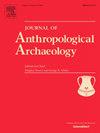动物考古记录中的觅食者和食物生产者的相互关系:来自中非的教训
IF 2.2
1区 社会学
Q1 ANTHROPOLOGY
引用次数: 0
摘要
动物分类丰度和组成经常被用作衡量史前食物生产者和觅食者之间不同层面的种群相互作用的一条证据线。本文对中非邻近的采集者和农民创造的民族考古动物群进行了比较分析,他们保持着部分基于野生资源交换驯化植物产品的持续互动。对这些组合的分析主要集中在是否可以利用区系特征来区分邻近的觅食者和食物生产者群体产生的组合;2)确定这些种群之间的相互作用;3)反映这些相互作用性质的信息。在这个样本中,测量骨骼丰度、分类丰富度和稀有物种的存在可以区分食物生产者和觅食者创造的组合。与采集者和农民群体相关的高成分相似性和开发强度表明,持续的经济活动集中在优势的可销售动物上。丰富度,骨骼丰度,特别是骨骼部分代表性的差异反映了以社会经济差异为特征的经济相互作用。这些结果为使用民族考古数据识别动物考古记录中的史前种群相互作用提供了重要指导,这些记录由持续的交换和/或市场活动定义,并且社会经济差异持续存在。本文章由计算机程序翻译,如有差异,请以英文原文为准。
Forager and food producer interrelationships in the zooarchaeological record: Lessons from Central Africa
Faunal taxonomic abundances and composition are often used as one line of evidence to measure different dimensions of prehistoric population interaction between food producers and foragers. This paper presents a comparative analysis of ethnoarchaeological faunas created by neighboring foragers and farmers in Central Africa who maintain on-going interactions based partly on the exchange of wild resources for domesticated plant products. Analysis of these assemblages is centered on whether faunal characteristics can be used to: 1) distinguish assemblages produced by neighboring forager and food producer populations; 2) identify interaction between these populations and; 3) reflect information about the nature of these interactions. In this sample, measures of bone abundances, taxonomic richness and the presence of rare species can distinguish food producer from forager-created assemblages. High levels of compositional similarity and exploitation intensity associated with forager and farmer assemblages indicate consistent economic activity focused on dominant marketable animals. Differences in richness, bone abundances and, especially, skeletal part representation of common marketable prey reflect economic interactions marked by socioeconomic disparities. These results provide an important guide to the use of ethnoarchaeological data in identifying prehistoric population interactions in the zooarchaeological record defined by sustained exchange and/or market activity and where socioeconomic disparities persisted.
求助全文
通过发布文献求助,成功后即可免费获取论文全文。
去求助
来源期刊

Journal of Anthropological Archaeology
Multiple-
CiteScore
4.00
自引率
11.10%
发文量
64
期刊介绍:
An innovative, international publication, the Journal of Anthropological Archaeology is devoted to the development of theory and, in a broad sense, methodology for the systematic and rigorous understanding of the organization, operation, and evolution of human societies. The discipline served by the journal is characterized by its goals and approach, not by geographical or temporal bounds. The data utilized or treated range from the earliest archaeological evidence for the emergence of human culture to historically documented societies and the contemporary observations of the ethnographer, ethnoarchaeologist, sociologist, or geographer. These subjects appear in the journal as examples of cultural organization, operation, and evolution, not as specific historical phenomena.
 求助内容:
求助内容: 应助结果提醒方式:
应助结果提醒方式:


